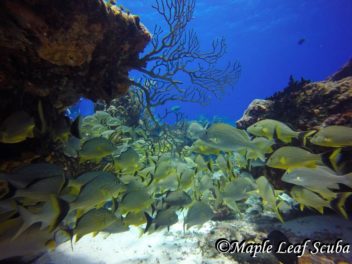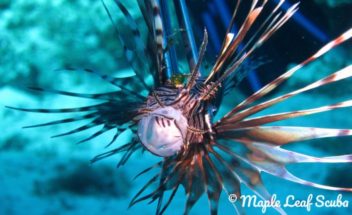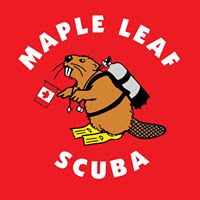

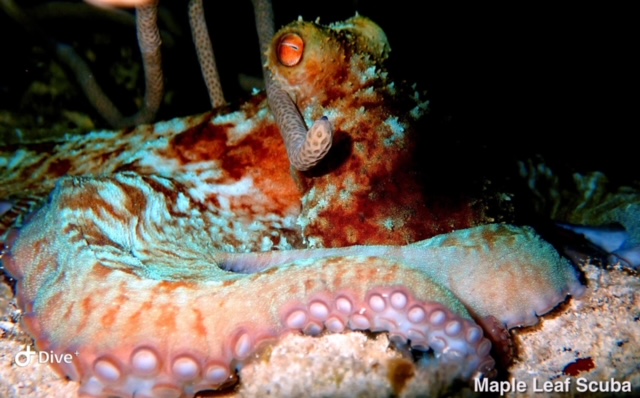
Night Diving
It all starts on the boat. Hopefully, you’ll be watching the Cozumel sunset as you cruise out to the reef. Once you reach the dive site, you begin to put on your gear and finish watching the beautiful sunset. Now it’s dark, it’s time to roll of the boat and discover the ocean at night. While you might think diving at night could be scary, somehow the darkness becomes soothing. Perhaps because the ocean seems smaller as you can only see with your flashlight or, it’s all the creatures lighting up before your eyes.
The most famous of the night is certainly the Octopus. It’s amazing how it glides across the sand stretching its tentacles in every direction while changing color to fit its surroundings all in the same moment. Lobsters and king crab are also popular visitors, you would be surprised by how big some of them look in person or by their curiosity. You also may think you know what a lobster looks like, but the Slippery lobster has flat claws and a flattened body, you might say it’s the biggest cockroach you have ever seen. Of course, let’s not forget the nurse shark, nocturnal in nature and can reach up to 14ft long but not to worry they are bottom feeders.
While some sea creatures are more active at night, some are trying to get some sleep like the parrot fish who wrap themselves in a fluorescent bubble of their own mucus to help mask their scent from predators. You might be saying that’s nasty but we promise it’s pretty cool. Or you may have the chance to come across our personal favorite, a sea turtle sleeping near or under a coral structure or coming up for air during the night.
Endemic to Cozumel is the sudden sound similar to a croak, you turn looking for a frog but a fish is staring you straight in the eyes, it’s a splendid toadfish using its mating call.
While no one ever wants the dive to end, eventually it is time to come up but the fun is not over then. Everyone turns off their light and we move our hands through the water to enjoy the bioluminescence. The water glistens with organisms and bacteria we can’t even see, but it is a spectacular site.
We left out our eel friends, rays and other little guys that grace our presence but all are equally as beautiful. Come join us on a night dive in Cozumel, we promise you will love it!
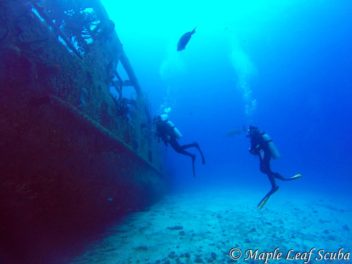
Ship Wreck C-53 Felipe Xicotencatl in Cozumel, Mexico
HISTORY OF THE C-53 WRECK
The C-53 was built in Tampa in 1944 at the Wilson Marine Ship Works. It was build as a mine sweeper for service during World War II named under Scuffles. After the war in 1946, it was decommissioned.
In 1962, the C-53 was discharged and sold to the Mexican Navy. It was converted into an Admiral Class Gunboat and retitled ARM General Felipe Xicoténcatl (C53). It was named after Felipe Santiago Xicoténcatl, who was a General in the Mexican Army.
The C-53 was purchased for the sole purpose of guarding the Gulf of Mexico and the Caribbean Sea in Search and Rescue operations. In addition to providing surveillance of illegal arms and drug trafficking.
Felipe Xicoténcatl (Cozumel C-53 shipwreck) provided 37 years of assistance to the Mexican Navy and was finally retired in 1999.
DEPTH
(50′-70’/15m-21m)
DIMENSIONS
The C-53 is 184 feet (56 meters) long, 33 feet (10 meters) wide. It was sunk to the bottom of the Caribbean perfectly upright. It rests on the seabed in 70 feet (21 meters) from the surface.
The Cozumel C-53 wreck stands 40 feet (12 meters) from the seabed permitting divers to reach the wreck by descending 30 feet (9 meters) from the surface.
LOCATION
It was sunk in Cozumel in June of 2000.
The location chosen for the wreck is just offshore from Chankanaab Park. The site was selected for many reasons including easy access for divers in an area sheltered from strong currents. It was lodged on a big sand bar where the ship would not cause any damage to the existing reef structures.
WHAT INSPIRED THE SINKING OF THE C-53
Sinking the C-53 as an artificial reef and dive attraction was designed and carried on by the ANOAAT (Cozumel Watersports & Tourism Association), in collaboration with local dive shops and the Parque Marino Arrecifes de Cozumel. The inspiration came from another place where ships had been successfully sunk by and for divers – Canada. This project started in 1998 at a DEMA show. Canadians were making artificial reefs for their diving areas by getting old boats from their government, cleaning and preparing them for sinking and diving them. This inspired Cozumel to do the same.
The plan behind its intentional sinking was to create an alternative site to help alleviate heavy traffic on nearby reefs.
DIVE DIFFICULTY
The C-53 is an easy to explore wreck with large openings to penetrate. The site is known to have the occasional strong current often making it sometimes a bit challenging to navigate.
It has easy access from all sides and at a depth that can be dove as a first or second dive.
WHAT MARINE LIFE WILL YOU SEE?
Inside you may see a giant Green Moray Eel along with Glassy Sweepers and depending on the season shoals of sardines. Sponges and coral are starting to form thick colonies on the metal of the wreck. Look carefully for tiny blenny’s, starfish and cleaner shrimp.
The exterior of the wreck remains relatively clean, likely due to the currents, but it boasts a great variety of marine life and sponges. Large schools of barracuda frequent the site along with groupers, morays eels and a wide variety of other reef fish.
